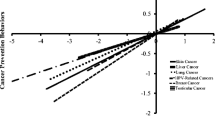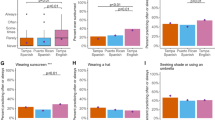Abstract
This study investigated knowledge, behaviors, and health beliefs of Australian university students (n=312) regarding skin cancers and evaluated the effects of videotaped presentations. Students' knowledge and health beliefs were assessed, and they then viewed either an informational video, an emotionally involving video, or a control video. Knowledge and beliefs were assessed immediately and 10 weeks later. Postvideo skin protection intentions increased significantly from prevideo assessment among the two intervention groups compared to the controls. Maintenance of skin protection intentions was higher with the emotional video. Health belief variables, particularly perceived barriers, were significant predictors of knowledge, intention, and behavior. However, other variables such as skin type and previous experience with skin cancer were more important. Females had greater knowledge and stronger intentions to prevent skin cancer than males but reported fewer high-risk behaviors.
Similar content being viewed by others
References
Ajzen, I., and Fishbein, M. (1980).Understanding Attitudes and Predicting Social Behavior, Prentice-Hall, Englewood Cliffs, N.J.
Armstrong, B. (1980). Cancer epidemiology: An Australian perspective. In Metcalf, D. (ed.)Cancer: Causes and Control. Australian Academy of Science, Canberra.
Australian Bureau of Statistics (1989).Causes of Death, Australian Government Publishing Service, Canberra.
Calnan, M. W. (1985). An evaluation of the effectiveness of a class teaching breast self examination.Br. J. Med. Psychol. 58: 317–329.
Counte, M. A., and Christman, L. P. (1981).Interpersonal Behavior and Health Care, Westview Press, Boulder, Colo.
Fraser, P. J. (1988).Environmental, Health and Economic Implications of the Use of Chlorofluorocarbons as Aerosol Propellants and Possible Substitutes, Australian Government Publishing Service, Canberra.
Goldsmith, M. F. (1987). Paler is better, say skin cancer fighters.JAMA 257: 893–894.
Gutteling, J. M., Seydel, E. R., and Wiegman, O. (1986). Perceptions of cancer.J. Psychosoc. Oncol. 4: 77–92.
Hibbard, J. H. (1984). Sex differences in health and illness orientation.Int. Q. Commun. Health Educ. 4: 95–104.
Hill, D., Rassaby, J., and Gardner, G. (1984). Determinants of intentions to take precautions against skin cancer.Commun. Health Stud. 8: 33–44.
Hill, D., Gardner, G., and Rassaby, J. (1985). Factors predisposing women to take precautions against breast and cervix cancer.J. Appl. Soc. Psychol. 15: 59–79.
Janz, N. K., and Becker, M. H. (1984). The health belief model: A decade later.Health Educ. Q. 11: 1–47.
Johnson, E. Y., and Lookingbill, D. P. (1984). Sunscreen use and sun exposure.Arch. Dermatol. 120: 727–731.
Kaufert, J. M., Rabkin, S. W., Syrotuik, J., Boyko, E., and Shane, F. (1986). Health beliefs as predictors of success of alternate modalities of smoking cessation: Results of a controlled trial.J. Behav. Med. 9: 475–489.
Keesling, B., and Friedman, H. S. (1987). Psychosocial factors in sunbathing and sunscreen use.Health Psychol. 6: 477–493.
Kling, B. W. (1984). Health education practice and the literature.Health Educ. Q. 11: 341–347.
Lau, R., Kane, R., Berry, S., Ware, J., and Roy, D. (1980). Channeling health: A review of the evaluation of televised health campaigns.Health Educ. 7: 56–89.
McClintock, A. (1985). Health education: A focus on cancer. InThe Health Educator, ACHPER, Sydney.
Mechanic, D., and Cleary, P. D. (1980). Factors associated with the maintenance of positive health behavior.Prev. Med. 9: 805–814.
Melanoma Foundation of Australia (1987).You, the sun and skin cancer (pamphlet), The Melanoma Foundation, Sydney.
New South Wales Cancer Council (1987).How to turn down the sun and save your skin (pamphlet), NSW Cancer Council, Sydney.
Nisbett, R., and Ross, L. (1980).Human Inference: Strategies and Shortcomings of Social Judgment, Prentice-Hall, Englewood Cliffs, N.J.
O'Connell, J. K., Price, J. H., Roberts, S. M., Jurs, S. G., and McKinley, R. (1985). Utilizing the health belief model to predict dieting and exercising behavior of obese and non-obese adolescents.Health Educ. Q. 12: 343–351.
Rook, K. S. (1987). Effects of case history versus abstract information on health attitudes and behaviors.J. Appl. Soc. Psychol. 17: 533–553.
Rosenstock, I. M. (1974). The health belief model and preventive health behavior.Health Educ. Monogr. 2: 354–386.
Stern, R. S., Weinstein, M. C., and Baker, S. G. (1986). Risk reduction for nonmelanoma skin cancer with childhood sunscreen use.Arch. Dermatol. 122: 537–545.
Sutton, S. R., and Eiser, J. R. (1984). The effect of fear-arousing communications on cigarette smoking: An expectancy-value approach.J. Behav. Med. 7: 13–33.
Taylor, S. E., and Thompson, S. C. (1982). Stalking the elusive “vividness” effect.Psychol. Rev. 89: 155–181.
Toneatto, T., and Binik, Y. (1987). The role of intentions, social norms, and attitudes in the performance of dental flossing: A test of the theory of reasoned action.J. Appl. Soc. Psychol. 17: 593–603.
Author information
Authors and Affiliations
Rights and permissions
About this article
Cite this article
Cody, R., Lee, C. Behaviors, beliefs, and intentions in skin cancer prevention. J Behav Med 13, 373–389 (1990). https://doi.org/10.1007/BF00844885
Accepted:
Issue Date:
DOI: https://doi.org/10.1007/BF00844885




